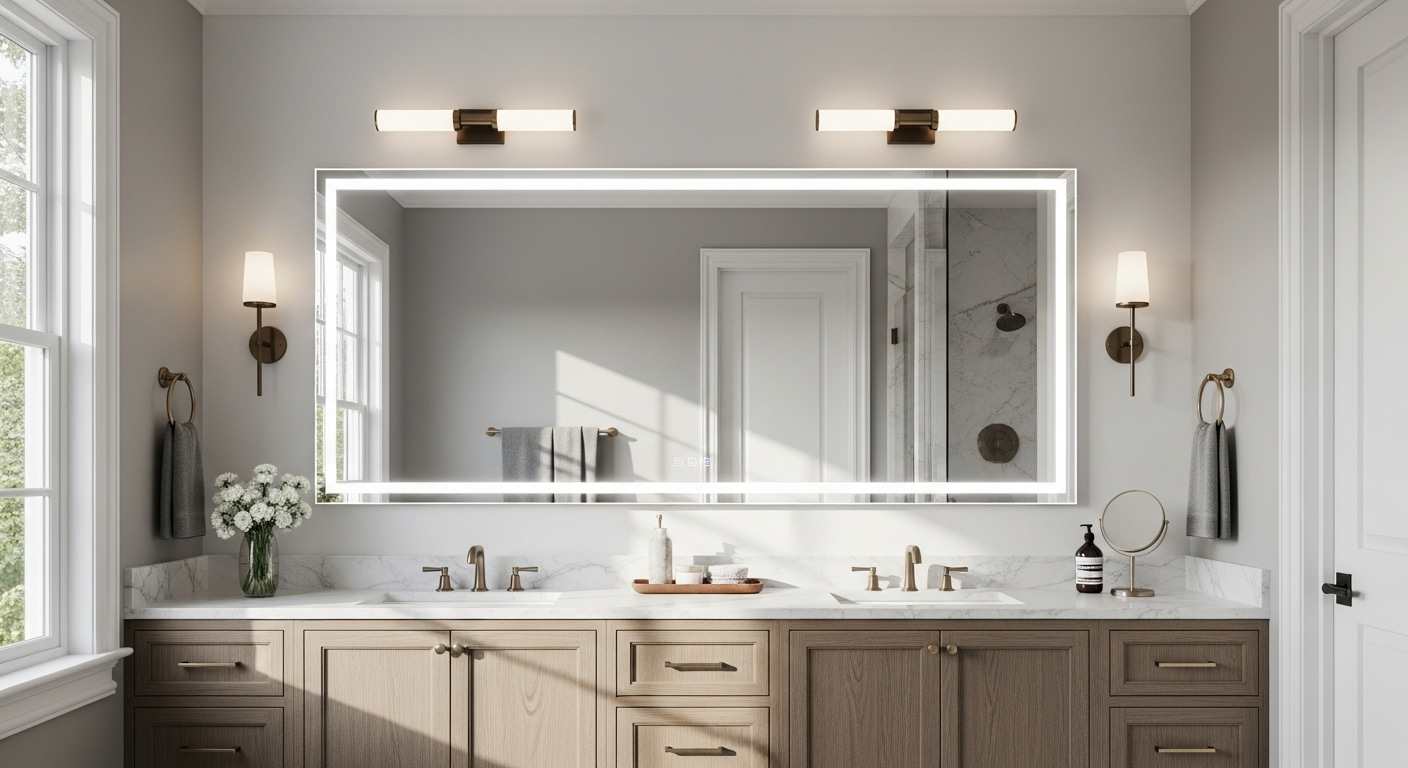After years on the job, I’ve learned that a bathroom mirror is far more than just a reflective surface. It’s a critical design element that can make or break a bathroom’s functionality, aesthetics, and even its perceived size. Homeowners often overlook the bathroom mirror’s potential, focusing solely on the vanity or tile. But trust me, a well-chosen mirror can transform your space, enhance lighting, and boost your daily routine.
- Bathroom Mirror Types: Shapes, Styles, and Materials
- Understanding Mirror Shapes and Their Aesthetic Impact
- Popular Bathroom Mirror Styles and Durable Materials
- Choosing the Right Bathroom Mirror Size and Dimensions
- LED Bathroom Mirrors: Benefits, Features, and Buying Guide
- Framed vs. Frameless Bathroom Mirrors: A Contractor’s Perspective
- Strategic Bathroom Mirror Placement and Lighting Design
- Frequently Asked Questions About Bathroom Mirrors
- Conclusion: Finding Your Perfect Bathroom Mirror
I’ve seen countless bathrooms, from cramped powder rooms to sprawling master ensuites, and the right mirror choice always makes a significant difference. It’s not just about what looks good in a showroom; it’s about what works in your actual home, taking into account light, moisture, and daily wear. That’s why I want to share some practical, on-the-ground insights to help you pick the perfect reflection for your next project, ensuring your bathroom mirror enhances your daily life.
Bathroom Mirror Types: Shapes, Styles, and Materials
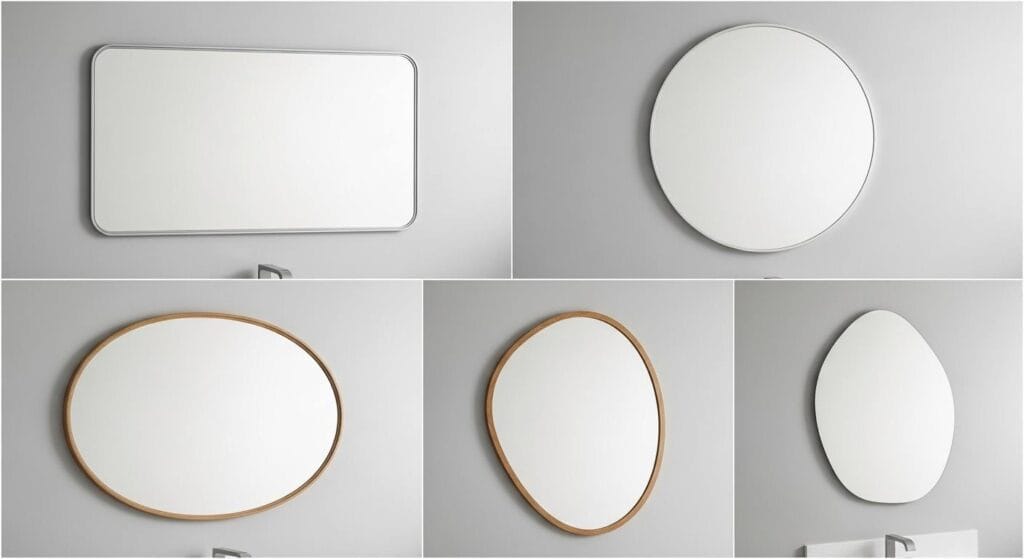
When I’m walking a client through their bathroom renovation options, one of the first things we discuss is the sheer variety of bathroom mirrors available today. It’s not just about a rectangle anymore; the market has exploded with shapes, sizes, and styles that cater to every taste and functional need. Getting this right from the start sets the tone for the entire room.
Understanding Mirror Shapes and Their Aesthetic Impact
Rectangular and square mirrors are, without a doubt, the most common. They’re versatile, easy to install, and complement almost any bathroom design, from a traditional farmhouse look to sleek modern minimalist. They provide a broad reflective surface, which is great for grooming, and their straight lines often align well with architectural elements like tile patterns or vanity edges. For instance, I recently installed a large rectangular mirror, about 36 inches by 48 inches, over a double vanity in a contemporary home. It visually expanded the entire wall and offered excellent utility for both homeowners.
Round and oval mirrors offer a softer, more organic aesthetic. They can break up the hard lines of a tiled wall or a rectangular vanity, introducing a sense of flow and elegance. I often recommend a round mirror, perhaps 24-30 inches in diameter, for a powder room or a single vanity where space is at a premium but you want to add a touch of sophistication. A common technique I use is to hang a round mirror slightly above the sink, pairing it with a wall-mounted faucet to create a spa-like feel. They’re particularly effective in bathrooms with curved elements, like a clawfoot tub or an arched doorway.
Unique or irregularly shaped mirrors are a growing trend, offering a custom, artistic touch. Think asymmetric designs, or even mirrors shaped like windows. While these can be stunning focal points, they often require more careful planning to ensure they don’t overpower the space. They work best in larger bathrooms where they can stand alone as a piece of art rather than competing with other elements.
Popular Bathroom Mirror Styles and Durable Materials
The style of your bathroom mirror is intrinsically linked to its frame (or lack thereof) and the overall aesthetic you’re aiming for.
For a modern, minimalist look, you’ll often see frameless mirrors with polished or beveled edges, or mirrors with very thin metal frames in black or brushed nickel. These integrate seamlessly into contemporary designs. When I’m working on a sleek, European-style bathroom, I often opt for a clean, frameless mirror to maintain those unbroken lines.
Traditional or classic bathrooms frequently feature framed mirrors with more ornate details. Solid wood frames, often stained or painted to match cabinetry, are popular here. I’ve installed many mirrors with solid oak or maple frames, sometimes with a distressed finish, for a truly timeless look. These frames aren’t just decorative; they offer a robust border that protects the mirror’s edges.
For an industrial or urban loft aesthetic, metal-framed mirrors, especially those with dark finishes like matte black or bronze, are excellent choices. I’ve also had clients ask for mirrors with exposed bolt details or thick, aged metal frames that evoke a factory feel. These are incredibly durable and make a strong statement.
When considering materials for your bathroom mirror, you need to think about more than just aesthetics. In a high-moisture environment like a bathroom, cheap particle board or MDF frames can quickly swell and delaminate. That’s why I always steer clients towards solid wood, metal alloys (like aluminum or steel), or high-quality composites designed for bathroom use. These materials hold up much better over time, resisting the warping and damage that humidity can cause.
Choosing the Right Bathroom Mirror Size and Dimensions
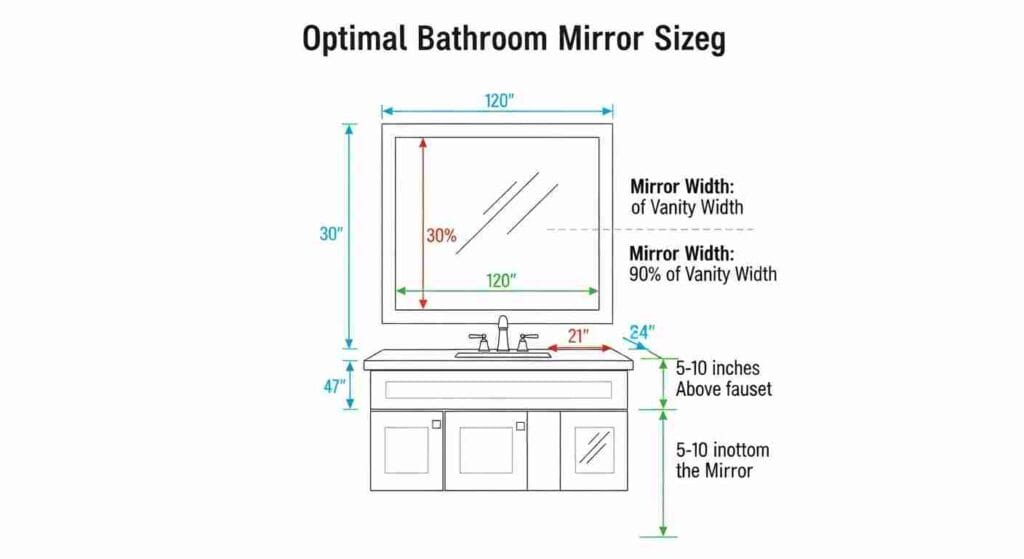
Choosing the right size bathroom mirror is one of the most critical decisions, and honestly, it’s where I see a lot of homeowners make mistakes. A mirror that’s too small looks lost and disproportionate, while one that’s too large can overwhelm the vanity and feel cramped. Getting the dimensions right isn’t just about fitting it on the wall; it’s about creating balance and maximizing functionality.
My primary rule of thumb, especially for bathroom mirrors placed directly above a vanity, is that the mirror should generally be narrower than your vanity. As a guideline, aim for the mirror to be between 70% to 90% of the vanity’s width. For example, if you have a 36-inch vanity, a mirror between 25 and 32 inches wide would look balanced. This slight difference creates a visual break and prevents the mirror from feeling like it’s spilling over the edges of the vanity.
For double vanities, you have two main options: one large mirror or two individual mirrors. If you go with a single, large mirror spanning both sinks, I recommend keeping it slightly narrower than the combined vanity width. On a recent project with a 72-inch double vanity, we opted for a single, frameless mirror that was 68 inches wide. It created a cohesive look and made the bathroom feel more expansive.
If you prefer two separate mirrors, ensure each mirror is centered over its respective sink and that its width is proportional to that sink’s section of the vanity. Don’t go too wide; aim for about 20-24 inches each for standard sinks.
When it comes to height, you need to consider a few factors. First, the bottom edge of the mirror should typically be installed about 5 to 10 inches above the top of your faucet or backsplash. This provides enough clearance for splashes and gives a clean line. The top edge often aligns with the top of a doorway or shower enclosure for visual consistency, or it can extend higher if you have high ceilings and want to draw the eye upwards. For instance, in a bathroom with 9-foot ceilings, I often recommend a taller mirror, perhaps 40-48 inches high, to fill the vertical space better, especially if there are no sconces interfering.
Don’t forget the scale of the room itself. A larger mirror can visually expand a small bathroom, making it feel brighter and more open by reflecting light and space. However, in a truly tiny powder room, an oversized mirror can feel overwhelming. Consider the overall volume of the room.
A full-length mirror on an opposing wall, for example, can be an excellent trick to double the perceived size of a narrow bathroom. Always measure your space multiple times, and even consider taping out the mirror dimensions on your wall with painter’s tape to visualize the scale before you buy. It’s a simple step that can prevent a costly mistake when choosing your bathroom mirror size.
LED Bathroom Mirrors: Benefits, Features, and Buying Guide
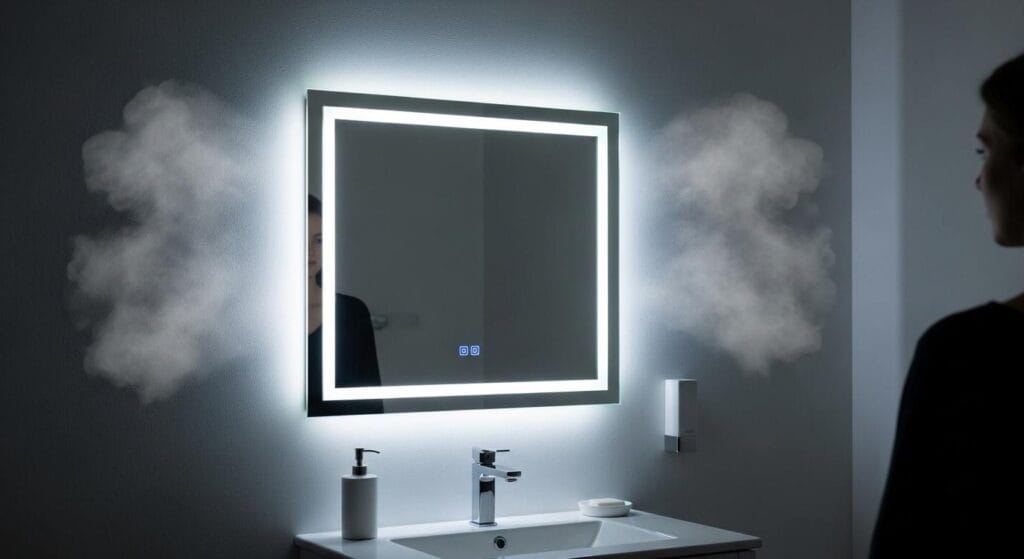
LED bathroom mirrors have quickly become a staple in modern renovations, and for good reason. From a contractor’s perspective, they offer a blend of cutting-edge design and practical benefits that traditional mirrors simply can’t match. If you’re considering an upgrade, an LED mirror is definitely worth a closer look.
One of the biggest benefits is the superior and even lighting they provide. Built-in LED strips illuminate your face directly, eliminating the harsh shadows that overhead lights or side sconces can create. This is fantastic for tasks like shaving, applying makeup, or styling hair, as it gives you a true, shadow-free reflection. I’ve had clients rave about how much easier their morning routine became after installing an LED bathroom mirror, saying they could finally see themselves properly.
They’re also incredibly energy-efficient. LED lights consume far less electricity than traditional incandescent bulbs, meaning lower utility bills and a smaller environmental footprint. Plus, they have a remarkably long lifespan, often lasting tens of thousands of hours. This translates to less maintenance and fewer bulb changes, which is a win for any homeowner.
Many LED mirrors come with convenient smart features that enhance their functionality. I’m talking about anti-fog pads (demisters), which keep a portion of the mirror clear even after a hot shower. This is a game-changer! Imagine stepping out of the shower and not having to wipe down the mirror. Other features include dimmable lighting, allowing you to adjust the brightness from a soft nightlight glow to full task lighting, and color temperature adjustment, letting you switch between warm (yellowish) and cool (bluish) light to mimic different environments.
Some even integrate digital clocks, temperature displays, or Bluetooth speakers. On a recent project, we installed a large Kohler Verdera mirror with an integrated anti-fog feature and dimmable lighting, and the clients were absolutely thrilled with the convenience.
When buying an LED bathroom mirror, here’s what I advise my clients to look for:
1. CRI (Color Rendering Index): This measures how accurately the light reveals true colors. For grooming, you want a high CRI, ideally 90 or above, to ensure colors (like your skin tone or makeup) look natural. Anything lower might make you look washed out or distort colors.
2. Kelvin Temperature: This determines the “warmth” or “coolness” of the light.
2700K-3000K (Warm White): Good for a relaxed, inviting ambiance.
4000K-5000K (Cool White/Daylight): Best for task lighting, as it mimics natural daylight and is excellent for precision tasks. Many LED bathroom mirrors offer adjustable Kelvin temperatures, which I highly recommend.
3. Dimmability: Essential for setting the right mood. Ensure the mirror’s dimming function is smooth and reliable.
4. Anti-Fog Feature: Look for a dedicated demister pad. It’s usually a heated element on the back of the mirror that prevents condensation.
5. Installation: Remember, LED mirrors require electrical wiring. You’ll need access to a dedicated electrical box or power outlet behind the mirror. If you’re not comfortable with electrical work, this is definitely a job for a licensed electrician to ensure it meets local codes and is safely installed.
Investing in a quality LED bathroom mirror isn’t just about having a pretty light; it’s about enhancing your daily routine and adding real value and sophistication to your bathroom.
Framed vs. Frameless Bathroom Mirrors: A Contractor’s Perspective
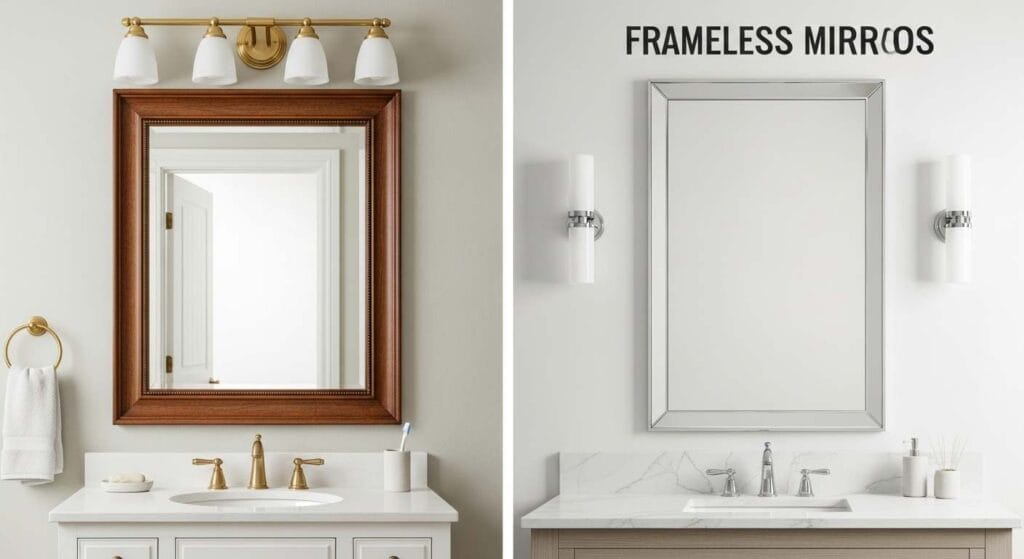
The choice between a framed and a frameless bathroom mirror is more than just an aesthetic preference; it impacts the longevity, maintenance, and overall feel of your bathroom. Having installed countless examples of both, I’ve seen the pros and cons play out in real-world scenarios.
Framed mirrors are excellent for creating a defined focal point and integrating the mirror into the room’s design scheme.
Pros of Framed Bathroom Mirrors:
Aesthetics: A frame can add character, warmth, or a touch of elegance, tying into your cabinetry, fixtures, or other decorative elements. I’ve used beautifully crafted wooden frames to complement a rustic vanity or sleek metal frames to match modern black faucets.
Design Integration: They act like a piece of art, completing the visual story of the room.
Perceived Durability: The frame protects the mirror’s edges from chips and impacts, which can be a plus, especially in busy households.
Easier Installation (sometimes): Many framed mirrors come with pre-installed hanging hardware, simplifying the mounting process for standard walls.
Cons of Framed Bathroom Mirrors:
Moisture Vulnerability: This is a big one. Cheap MDF (medium-density fiberboard) or particle board frames, if not properly sealed or if exposed to constant splashes, can swell, peel, and delaminate over time. I’ve seen too many budget-friendly frames look terrible after just a few years in a humid bathroom. If you go framed, invest in quality materials like solid wood treated for moisture, or metal frames.
Cleaning: Dust and grime can accumulate in the crevices and corners of the frame, making cleaning slightly more involved.
Bulk: Depending on the frame’s thickness, a framed mirror can feel heavier or bulkier in a small space, sometimes making the room feel smaller.
Frameless mirrors offer a sleek, often minimalist look that has gained immense popularity.
Pros of Frameless Bathroom Mirrors:
Minimalist Aesthetic: They create an uncluttered, seamless look that works exceptionally well in contemporary, modern, or transitional bathrooms. They almost disappear into the wall, letting the focus be on the reflection and the space itself.
Expansive Feel: By eliminating the visual barrier of a frame, frameless mirrors often make a bathroom feel larger and brighter, reflecting more light and giving an open, airy impression. This is a trick I use often in smaller powder rooms.
Easier Cleaning: Without a frame, there are no nooks or crannies for dust to collect. A quick wipe down is usually all it takes.
Moisture Resistance: With polished or beveled edges, there’s no frame material to warp or degrade due to humidity, making them very durable in the long run.
Cons of Frameless Bathroom Mirrors:
Edge Exposure: While durable, the exposed edges (even if polished) can be vulnerable to chipping if hit directly. This is why careful installation is paramount.
Installation: Hanging large frameless mirrors sometimes requires special clips or mastic adhesive, which needs precise application to ensure stability and proper bonding. It’s not a job for the faint of heart, especially with larger pieces.
Less “Finished” Look (for some): Some homeowners prefer the visual weight and distinct boundary a frame provides, feeling that frameless mirrors can appear a bit unfinished if not integrated perfectly into the design.
In my experience, if your budget allows for a quality framed mirror made of moisture-resistant materials, it can add significant character. However, for a clean, low-maintenance, and visually expansive solution, a frameless mirror with polished or beveled edges is often the more practical and durable choice in the long run, especially in high-use bathrooms.
Strategic Bathroom Mirror Placement and Lighting Design
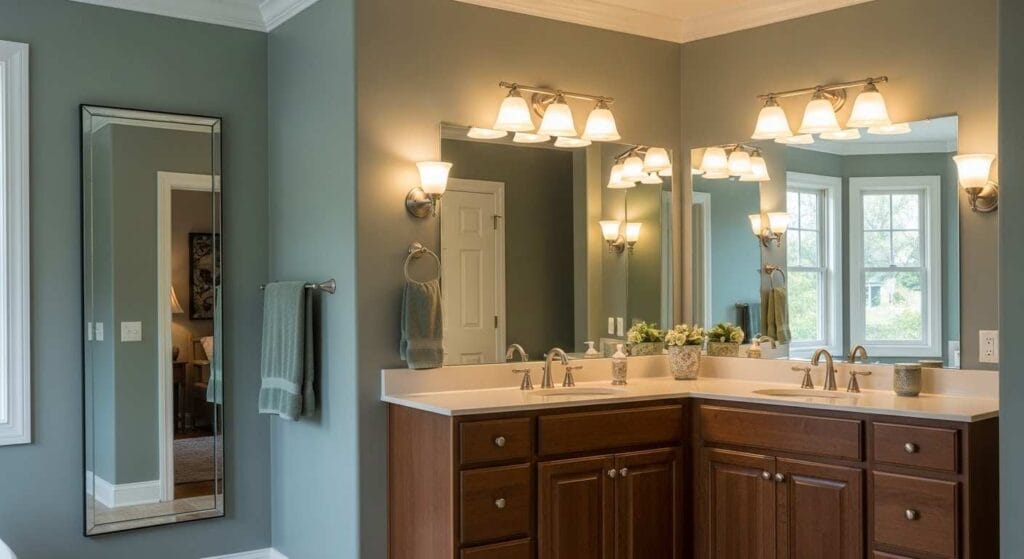
When I plan a bathroom renovation, I don’t just think about where the vanity mirror goes; I consider the entire room as a system of light and reflection. Strategic bathroom mirror placement can vastly improve both the functionality and the ambiance of your bathroom.
Of course, the most common placement is centered over the vanity. This is your primary grooming station, so the mirror needs to be at a comfortable height for everyone using it. Generally, I ensure the top of the mirror is at a good height for the tallest user, and the bottom is high enough to clear the faucet and any backsplash, typically about 5 to 10 inches above the vanity top. But don’t just stop there.
Have you ever considered a full-length mirror in your bathroom? Even if it’s a smaller bathroom, a narrow full-length mirror on an unused wall can work wonders. It’s not just for checking your outfit; it reflects light, making the room feel significantly larger and brighter. I often install these on the wall opposite a window or a main light source to maximize this effect. It’s amazing how much light a strategically placed mirror can bounce around a room.
Another clever trick is to place a smaller, decorative mirror on an adjacent wall, perpendicular to the main vanity mirror. This isn’t for grooming, but purely for aesthetics. It adds depth and can reflect a particularly nice tile pattern or an interesting light fixture, adding another layer to your design.
Now, let’s talk about lighting integration because a mirror is only as good as the light that hits it. A common mistake I see homeowners make is relying solely on an overhead light. This creates harsh shadows on your face, making grooming difficult and unflattering.
My go-to solution is usually a combination of:
1. Vanity Sconces: Placing sconces on either side of the mirror at eye level, around 60-65 inches from the floor, provides even, cross-illumination. This is ideal for tasks like applying makeup or shaving because it eliminates shadows from the sides.
2. Overhead Vanity Lighting: A strip light or recessed cans directly above the mirror can supplement the sconces, providing overall illumination without being the sole light source.
3. Dimmable Lighting: This is non-negotiable in my book. Being able to adjust the brightness from a soft glow for a relaxing bath to bright task lighting for detailed work makes a huge difference in the usability of the space.
If you opt for an LED mirror with integrated lighting, you might not need additional sconces. However, always ensure the integrated light is sufficient for task lighting (check its lumen output and CRI). For a truly balanced lighting scheme, I still often pair an LED mirror with a couple of recessed lights in the ceiling to provide ambient light for the rest of the bathroom. It’s all about layering light to create both functionality and atmosphere with your chosen bathroom mirror.
Frequently Asked Questions About Bathroom Mirrors
How do I clean a bathroom mirror without streaks? For a streak-free shine on your bathroom mirror, I always recommend a two-step approach. First, use a microfiber cloth specifically designed for glass with a mixture of equal parts white vinegar and distilled water, or a high-quality ammonia-free glass cleaner. Spray lightly onto the cloth, not directly onto the mirror, to avoid drips. Then, use a second, dry microfiber cloth or even a crumpled piece of newspaper to buff the mirror until it’s perfectly dry and sparkling. Avoid paper towels; they often leave lint.
Can I install a regular mirror in a bathroom, or does it need to be special? While you technically can install any mirror, I strongly advise against using a standard mirror not rated for bathroom use, especially if it’s framed. The high humidity and temperature fluctuations in a bathroom can cause the silvering (the reflective coating on the back) to delaminate and the frame to swell or warp. Always look for mirrors specifically labeled as “bathroom mirrors” or “moisture-resistant.” These are designed with durable backings and, if framed, use materials that can withstand the unique bathroom environment.
What’s the best way to hang a heavy mirror safely? Hanging a heavy bathroom mirror requires careful planning and the right hardware. First, locate the wall studs using a stud finder; hanging a heavy mirror directly into drywall without proper anchoring is asking for trouble. If you can hit studs, use long, heavy-duty screws (2.5-3 inches). If studs aren’t an option, you’ll need toggle bolts or self-drilling drywall anchors rated for the mirror’s weight (always go beyond the mirror’s actual weight for safety). I always recommend using at least two, preferably three, anchor points for wider mirrors, spaced evenly. If the mirror is exceptionally large or heavy, consider professional installation or a French cleat system for maximum security.
Are smart mirrors worth the investment? Smart mirrors, with features like integrated displays for news, weather, or even fitness tracking, are certainly a luxury item. From a practical standpoint, the core benefit for most homeowners is the integrated LED lighting, anti-fog feature, and possibly dimming capabilities. The added “smart” functionalities can be fun and convenient, but their value really depends on how much you’ll actually use them daily. They are an investment, so consider if those extra features truly align with your lifestyle. For many of my clients, a well-designed LED bathroom mirror with good lighting and an anti-fog pad offers the most practical value without the higher price tag of a fully “smart” system.
Conclusion: Finding Your Perfect Bathroom Mirror
Choosing the right bathroom mirror is a decision that impacts both the aesthetics and functionality of your space for years to come. From understanding the nuances of shape and style to picking the perfect size and integrating it with effective lighting, each choice plays a vital role. As a contractor, I’ve seen firsthand how a thoughtful mirror selection can elevate a bathroom from ordinary to extraordinary. Take your time, consider your specific needs, and don’t hesitate to visualize your options. A little planning goes a long way in finding that perfect reflection for your home.
How do I clean a bathroom mirror without streaks?
For a streak-free shine, use a microfiber cloth with a white vinegar and distilled water mixture or an ammonia-free cleaner. Spray lightly onto the cloth, then buff with a second dry microfiber cloth or crumpled newspaper until sparkling.
Can I install a regular mirror in a bathroom, or does it need to be special?
While technically possible, it’s strongly advised against using standard mirrors not rated for bathroom use. High humidity can delaminate the silvering and warp frames. Always choose mirrors specifically labeled as “bathroom mirrors” or “moisture resistant.”
What’s the best way to hang a heavy mirror safely?
Locate wall studs with a stud finder and use long, heavy-duty screws. If studs aren’t available, use toggle bolts or self-drilling drywall anchors rated beyond the mirror’s weight. Use at least two, preferably three, anchor points for wider mirrors. Consider professional installation for exceptionally large items.
Are smart mirrors worth the investment?
Smart mirrors are a luxury item. Their core practical benefits often revolve around integrated LED lighting, anti-fog features, and dimming. The value of additional “smart” functionalities depends on daily usage and lifestyle alignment, as they come with a higher price tag. A quality LED mirror often provides the most practical value.




